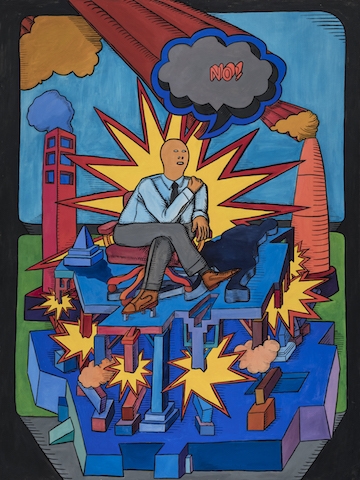Vibrant and vulgar, the Hairy Who’s irreverent, Pop-like paintings were inspired as much by commercial culture as by what they found on Chicago’s city streets. From 1966 to 69, its members – Jim Falconer, Gladys Nilsson, Jim Nutt, Suellen Rocca and Karl Wirsum – developed a libidinous and deeply idiosyncratic approach to artmaking. Then, after six exhibitions together, they broke up. And here’s where things get blurry: former members joined new collectives, and this widening circle of artists, which included aesthetic sympathisers like Roger Brown, Ed Paschke, Christina Ramberg and Barbara Rossi, became known collectively as the Chicago Imagists. What then makes the Hairy Who the Hairy Who, and not the Imagists?
Hairy Who? 1966–1969 attempts to answer this question by restaging all six of the group’s exhibitions. The first three originally took place at the Hyde Park Art Center on the southside of the Windy City, then under the curatorship of Don Baum, a key figure in the Hairy Who’s rise to cult stardom. On the strength of these shows, the group seems to have emerged fully formed, with each member working a complementary aesthetic. Gameplay is at the heart of Rocca’s Bare Shouldered Beauty (1965), which insinuates a female figure into an inscrutable boardgame motif; the same absurdist logic also underpins Green’s Consider the Options, Examine the Facts, Apply the Logic (1965), his ironic takedown of former secretary of defense Robert McNamara. It’s satisfying to see Nutt’s drawing study for Wiggly Woman (1966) next to the painting itself: his careful modulations between media appear coolly undisturbed by the figure with an outrageous blonde bouffant and protruding tongue. Nilsson may have abandoned toxic paints for watercolours early on, but a few of her quixotic Plexiglas works are present. The pudgy and dimpled figures in Candy Outside (1966) are as bright as Pepto-Bismol.
By the third show, the Hairy Who had mastered the use of installation and began to spoof their own success. Department store price tags dangled from some of the paintings, and this retrospective recreates a swathe of bright linoleum on which Falconer hung paintings; Wirsum meanwhile displayed Untitled (1967), a throbbing, veiny skull-and-crossbones. Geographic distance seems to have constrained their fourth show, in San Francisco, and a janitor accidentally threw out a whole crate at their fifth in New York. Their sixth and final exhibition, at the Corcoran Art Gallery in Washington, DC, demonstrates, however, that their jokiness never subsided. It includes a 1969 set of painted metal lawn chairs by Nutt and Wirsum. The former’s is the funnier: a putrid yellow liquid rains from a wrinkled pair of boxer shorts painted on the seat back, with the work’s title – I’m Wet – appearing on the seat itself. The curators also dug up all of the Hairy Who’s self-produced exhibition ephemera. Unable to afford catalogues, they designed and printed comic books for every show, perhaps the only objects the entire group signed their name to.
The six exhibitions show a handful of middle-class Midwestern white kids who were preoccupied with their hometown, and who possessed a formal rigour beyond what might be expected from their youth (the youngest members were twenty-three when the first show opened). That said, considering that little changed between their first exhibition and last, there also appears to have been a limit to their ideas, and the number of combinations between their works. So, what makes the Hairy Who the Hairy Who? Is it this collection of a few dozen works? The show makes a compelling argument for an art history that is painstakingly precise, but, based on the inscrutable quality to their work, I suspect most of the artists would tell you that the question is unanswerable. That that is what motivated them in the first place.
Hairy Who? 1966–1969 at Art Institute of Chicago, through 6 January
From the December 2018 issue of ArtReview
